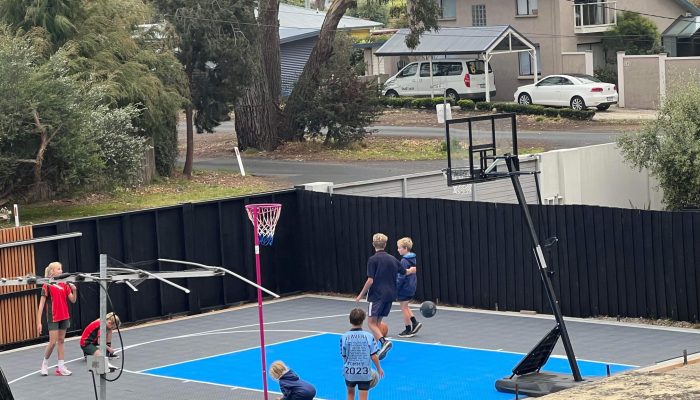Creating a fully functional and successful home basketball is a highly rewarding experience, which can bring you, your family (and often your neighbours) a high level of enjoyment for many years to come.
Building a home court requires careful planning, consideration and knowledge of the right type of products to suit your home, which is why we have prepared a handy guide to help homeowners build a court that fits seamlessly into you property.
1. Ensure a Smooth and Flat Surface:
No on wants to be balling on a rocky, uneven surface which is why a smooth and even foundation of your basketball court will positively affect its playability and safety. Make sure you excavate the area profesionally to remove any debris, tree roots and create a level playing surface. Don’t skimp on this section, because if you get it wrong, it could ruin your court for years to come.
Applying a concrete slab of at least 100mm thickness ensures long term durability and a flat surface. Ideally, position your slab and court away from neighbours boundaries to minimize disturbance and keep the peace.
2. Build a Court That Suits Your Yard
This may sound simple, but you really need to design your court to complement your yard, and not just what you think your kids ask for (the biggest and best possible). Consider the ideal length and width that fits the available space while avoiding placement near windows or areas where balls could escape over fences or into the street. Ensure there’s enough surface area around the hoop for free throws and potentially layups, however don’t sell your yards soul for a court. You need to consider what you can do with that space once your kids have grown up or even flow the nest. Can you make that slab into an entertaining area? Can you lay fake turf? All of these need to be taken into consideration before you build a court.
3. Choosing the Right Type of Basketball Tile or Surface
Most of your choices will come down to keeping an existing slab, laying artificial turf or investing in outdoor basketball tiles.
For modern and safe play, we recommend new modular polypropylene tiles with rubber cushions that clip together. This surface offers excellent drainage, durability, and safety, making it a top choice for homeowners.
4. Choose the Best Type of Basketball Hoop
Selecting a hoop which fits your needs, budget and yard is very important. A solid, in-ground hoop provides stability for rigorous play, however these are cemented into position, and are therefore a permanent fixture.
While an above-ground hoop offers flexibility and cost savings, however these do not look as professional, are prone to weating over time and don’t have the same look and feel as the more expensive in-ground option. If you want a hoop that can be moved with ease and tucked away during social events, this might be more your style. Also consider features like height adjustability and durability when making your choice.
5. Applying Court Markings
Professional court markings enhance the playing experience and look great on a home court. If you are buying basketball tiles, it’s worth asking your provider if they offer pre-marked tiles? If they don’t or they cost too much, you want to even consider painting the lines yourself.
Popular lin markings include a free-throw line, three-point line (if you have the space), and baselineto name a few. Many of the main court providers will provide customised logos for an additonal charge.
6. Fence Netting Considerations
There is nothing worse that shooting hoops and chasing a ball oll over your yard, down your street or over the neighbourd fence.
To prevent balls from leaving the court, install some fence netting can be a smart move. Determine the appropriate height based on your court location and accessability. Many systems are DIY-friendly and can also help rebound balls back into play.
7. Lighting Your Court
Court positioning is important as you also need to evaluate the natural light hours and its impact on your court time. A genuine home court investment should include potential floodlights for evening play (neighbours permitting). Position the lights strategically to avoid glare and shadows, ensuring they don’t shine directly into players’ eyes. Solar-powered lights can be an eco-friendly option.
8. Court Maintenance
Choose a surface that’s easy to maintain and suited to your climate. When choosing between keeping a concrete or tiles surface versus artificial turf versus the newer module bsketball tiles, consider how quickly they dry after rain, how easy they are to clean and mantain and how resistant each is to long term wear and tear. You will want to keep a 5-10 year perspective in mind, and also factor in that regular maintenance, cleaning and inspections will extend the life of your court.
Before you build your ideal home basketball court, consider these tips to ensure long term successful game play. Homeowners can create a basketball court that not only enhances their property but also provides a safe and enjoyable space for sports and recreation. Whether you’re practicing your layups, hosting friendly games, or teaching the next generation of players, a well-planned basketball court is a valuable addition to any home.
Remember, the key to a successful home basketball court lies in thorough planning, quality materials, and regular maintenance. With these elements in place, you can enjoy countless hours of fun and fitness right in your own backyard.

